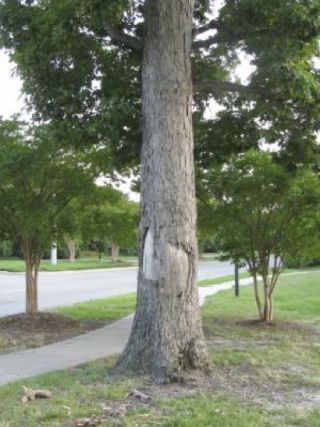After every local windstorm, there will be no shortage of dramatic footage and photographs of storm damaged trees. News crews will rush to the scene of greatest damage and broadcast the destruction to every tuned-in television in Hampton Roads. But as an arborist with more than twenty years of experience—I’ve worked hurricanes from Florida to Virginia, winter ice storms from the east coast to the midwest—I rarely see storm damaged trees that didn’t have an obvious cause. A cause that could have been mitigated by a trained arborist with expertise in tree risk assessment. If we treat trees with care and understand how they grow, we can eliminate irrational fears we may have about tree failure, and live comfortably with trees, enjoy their beauty and all the ecological services they provide.
After Hurricanes Bonnie, Isabel, and Irene, in 1998, 2003, and 2011, the overwhelming majority of Hampton Roads’ trees—deluged with rainwater, and blasted with severe winds—stood strong and remained upright. Hurricane force winds have been seasonally pounding the east coast for millions of years. By adapting to local weather conditions, our native coastal tree populations have the strength to withstand tropical storm wind speeds. The strength of a mighty live oak lies deep in the nucleus of each cell, in its DNA, with digital instructions on how to construct a tree that can survive and reproduce along the southeastern coast.
The truth is that people endanger trees far more than trees endanger people. Large numbers of tree failures are precipitated by the actions of people. It’s generally true that people don’t knowingly and intentionally inflict mortal injuries to trees, but because of a general and widespread ignorance about basic tree physiology, trees are often viewed more as a lifeless telephone pole, and less like a living organism that needs a healthy environment to thrive. Unfortunately many of the culprits are the tree workers themselves, laboring diligently to profit the tree service, but unaware of the ultimate effect their labors have on long term tree health and stability.
If you took your pet to the animal hospital to undergo surgery, you would not attempt to advise the veterinarian about the techniques and methods to remove a cancerous skin mass. If you want a successful outcome, you find the best trained and experienced veterinarian available and you trust her to produce the same successful results she has for many other pet owners. Likewise if you want to enjoy the benefits of trees and decrease the associated risk, you should find the best trained and experienced arborist to evaluate your trees. But unlike veterinarians—anyone, with no training or understanding of tree physiology—can advertise themselves as an arborist. It’s up to you to be a responsible property owner and educate yourself on how to find a knowledgeable and caring arborist.
It’s true, this comparison is unsatisfactory. The scientific literature on animal health care is immense and requires years of formal education and training to obtain an acceptable level of expertise. Scientific research on tree biology and tree biomechanics is far less voluminous, yet it exists in surprising detail. However there is no regulatory agency that requires your arborist to be well versed in the pertinent literature and to practice scientifically literate arboriculture. Before soliciting advice about tree risk and possible tree failure from an arborist, be sure they have the expertise to offer sound advice.
Reading this short article is a first step to becoming a conscientious steward of trees. Using the many online resources of the International Society of Arboriculture will improve your ability to understand and communicate effectively with a knowledgeable arborist.
Why Do Trees Occasionally Fail?
Higher than normal wind speeds combined with a structurally defective tree can result in tree failure. Often, heavy rain, snow, or ice is a contributing factor. Though we cannot control weather conditions, we can inspect trees prior to storm conditions. Some of the common defects that can lead to failure are:

White oak predisposed to failure from trunk damage caused by careless construction activities
- Codominant stems with included bark
- Dead, broken, or hanging branches
- Severed, girdling or decayed root systems
- Tree architectural abnormalities
- Cracks, external and internal
- Decayed wood and cavities
What most people don’t realize is that many of these defects are caused by our poor treatment of trees. If we remove the tree’s food producing foliage, damage its bark, sever its roots, restrict, compact, and poison the soil, it’s not realistic to expect the poor creature to stand strong in a fierce storm.
However with proper care and attention, the most common problems can be prevented before they occur. Moreover, with proper inspections by a skilled arborist, any defects that may be present can often be mitigated by pruning, installing structural support, improving site conditions, using growth regulators, or simply by moving a valuable target.
If we are to enjoy the benefits of trees, we must accept some risk. Proper care and treatment of our trees based on sound science is the key to minimizing that risk. Our efforts will be rewarded with the beauty and valuable ecological services that only trees can provide.
